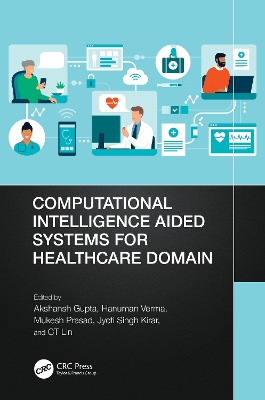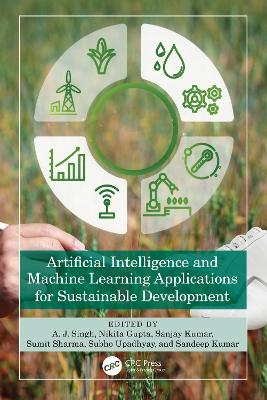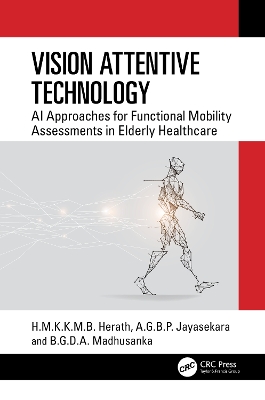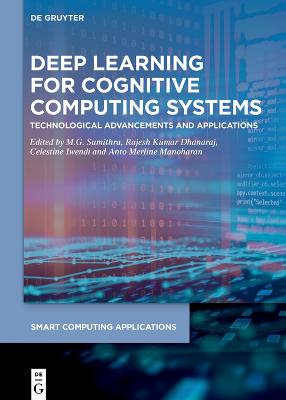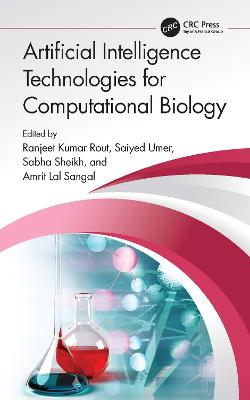Smart Distributed Embedded Systems for Healthcare Applications
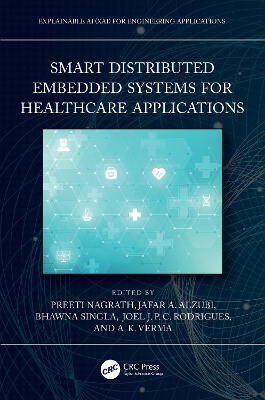 portes grátis
portes grátis
Smart Distributed Embedded Systems for Healthcare Applications
Rodrigues, Joel J. P. C.; Singla, Bhawna; Alzubi, Jafar A.; Verma, A. K.; Nagrath, Preeti
Taylor & Francis Ltd
11/2024
184
Mole
9781032183497
Pré-lançamento - envio 15 a 20 dias após a sua edição
Ashish Kumar, Bennett University, Greater Noida, Uttar Pradesh, India
Prince Sareen, Bharati Vidyapeeth's College of Engineering, New Delhi, India
Aman Arora, University of Texas, Austin, USA
1.1 Introduction:
1.2 Related work
1.3 Impact of AI in the healthcare industry
1.4 Transforming healthcare with distributed computing
1.5 AI-based Robots in the healthcare ecosystem
1.6 Conclusion and Future Scope
Chapter 2: Cloud Computing in Healthcare: A Systematic Study
Raunak Negi, Jishnu Bhardwaj, and Preeti Nagrath
Bharati Vidyapeeth's College of Engineering, New Delhi, India
2.1. Introduction
2.2. Literature Review
2.3. MEDLINE
2.4 Monitoring Software for the Cloud
2.5 Biomedicine and healthcare benefit from cloud computing
2.6 Biotech Solutions in the Cloud
2.7. Cloud-based Molecular Simulation Tools
2.8 Cloud-based Medical Imaging Solutions
2.9. Medical Solutions in the Cloud
2.10. Fog computing and healthcare
2.11. Threats with cloud computing
2.12. Future Research
2.13 Conclusion
Chapter 3: Medical Information Extraction of Clinical Notes and Pictorial Visualization of Electronic Medical Records Summary Interface
Praveen Singh and Gopal Chaudhary
Bharati Vidyapeeth's College of Engineering, New Delhi, India
Joao Alexandre Lobo Marques
University of Saint Joseph Macau, China
3.1 Introduction
3.2 Related works
3.3 Pictorial Visualization of data
3.4 Methodology for information extraction
3.5 Results
3.6 Conclusion and future work
Chapter 4: Investigations on RFID Enabled Healthcare Usage and Adoption Issues
Pankaj Palta, Rahul Kakkar, Sumeet Goyal, Manvinder Sharma
CGC - College of Engineering, Punjab, India
Joginder Singh, Chandigarh Group of Colleges, Punjab, India
4.1 Abstract
4.2 Background
4.3 RFID in Health Care System
4.4 RFID Adoption Issues
4.5 Conclusion
References
Chapter 5: Photonic crystal fiber plasmonic sensor for applications in medicine
Monika Kiroriwal and Poonam Singal
Deenbandhu Chhotu Ram University of Science & Technology, Murthal, Haryana, India
5.1 Introduction
5.2 Background and development of photonic crystal fiber
5.3 Plasmonic sensor based on photonic crystal fiber
5.4 Fabrication Techniques
5.5 Future applications of plasmonic sensors
5.6 Conclusion
Chapter 6: (Augmented reality as a boon to disability)
Ashish Kumar
Bennett University, Greater Noida, Uttar Pradesh, India
Raja
Bharati Vidyapeeth's College of Engineering, New Delhi, India
Muhammad Fazal ljaz
Sejong University, Seoul, South Korea
6.1 Introduction: Aim and real use cases of augmented reality
6.2 Related work And Discussion
6.3 Technology Advancement Using AR for Empowering Disabled People
6.4 AR solutions for teaching specialized students
6.5 AR accessible technology to people
6.6 Conclusion
Chapter 7: (Augmented and Virtual Reality: Transforming the Future of Psychological and Medical Sciences)
Gurjinder Singh, Anjali Kataria, Shinnu Jangra, Rubina Dutta, Archana Mantri
Chitkara University Institute of Engineering and Technology, Punjab, India
Jasminder Kaur Sandhu
Chandigarh University, Gharuan, Mohali, India.
Thennarasan Sabapathy
Universiti Malaysia Perlis (UniMAP),
Perlis, Malaysia
7.1. Introduction
7.2 Use of AR Technology in Medical Science
7.3 Challenges and Opportunities
7.4 Conclusion
Chapter 8: Artificial Intelligence in Healthcare: Perspectives from Post-Pandemic times
Tapash Rudra
Amity Institute of Biotechnology, Amity University, Kolkata, India
Shyam Bihari Goyal
City University, Selagor, Malaysia
8.2 Introduction
8.3 Applications of artificial intelligence (AI) in healthcare before Covid-19 pandemic
8.4 An Account of artificial intelligence (AI) guided aids in healthcare: Scenario from post pandemic times
8.5 Discussion
8.6 Conclusion
Chapter 9: Bioweapons v/s Computer Based Counter Measure Techniques and Mathematical modeling for prediction of Covid-19
Joginder Singh, Gurinderjit Kaur
Chandigarh Group of Colleges, Landran, Punjab, India
Rinkesh Mittal, Sukhdeep Kaur, Kuldeep Sharma
Chandigarh Engineering College, Landran, Punjab, India
9.1 Introduction and history
9.2 Genetically Engineered pathogens
9.3 Counter measure by computer based techniques
9.4 Mathematical model for COVID-19 Prediction
9.5 Conclusion
Chapter 10: Evolution of Healthcare Sector and Evolving Cyber Attacks - A Summary
Jai Ganesh Sekar, Arun Chokkalingam, Dhivya Kesavan
RMK College of Engineering and Technology, Tami Nadu, India
10.1 Healthcare industry and its revolution:
10.2 Role of Distributed System in Health Care
10.3 Why Healthcare is the biggest target for cyber attackers?
10.4 Cyber-attacks in healthcare industries - an infographic
10.5 Most frequent attacks in health industries and remedial measures
10.6 Research trends in cybersecurity for the health care sector
10.7 Conclusion - Defending Healthcare sector from Cyberattacks
Chapter 11: Improving Cardiovascular Health by Deep learning
Shiva Tushir,
Panipat Institute of Engineering and Technology, Samalkha, Panipat, India
11.1 Introduction
11.2. Machine Learning
11.3 Next Generation Machine Learning
11.4 Applications of Artificial Intelligence for Cardiovascular Health
11.5 Future Scope
11.6 Challenges
11.7 Conclusion
Ashish Kumar, Bennett University, Greater Noida, Uttar Pradesh, India
Prince Sareen, Bharati Vidyapeeth's College of Engineering, New Delhi, India
Aman Arora, University of Texas, Austin, USA
1.1 Introduction:
1.2 Related work
1.3 Impact of AI in the healthcare industry
1.4 Transforming healthcare with distributed computing
1.5 AI-based Robots in the healthcare ecosystem
1.6 Conclusion and Future Scope
Chapter 2: Cloud Computing in Healthcare: A Systematic Study
Raunak Negi, Jishnu Bhardwaj, and Preeti Nagrath
Bharati Vidyapeeth's College of Engineering, New Delhi, India
2.1. Introduction
2.2. Literature Review
2.3. MEDLINE
2.4 Monitoring Software for the Cloud
2.5 Biomedicine and healthcare benefit from cloud computing
2.6 Biotech Solutions in the Cloud
2.7. Cloud-based Molecular Simulation Tools
2.8 Cloud-based Medical Imaging Solutions
2.9. Medical Solutions in the Cloud
2.10. Fog computing and healthcare
2.11. Threats with cloud computing
2.12. Future Research
2.13 Conclusion
Chapter 3: Medical Information Extraction of Clinical Notes and Pictorial Visualization of Electronic Medical Records Summary Interface
Praveen Singh and Gopal Chaudhary
Bharati Vidyapeeth's College of Engineering, New Delhi, India
Joao Alexandre Lobo Marques
University of Saint Joseph Macau, China
3.1 Introduction
3.2 Related works
3.3 Pictorial Visualization of data
3.4 Methodology for information extraction
3.5 Results
3.6 Conclusion and future work
Chapter 4: Investigations on RFID Enabled Healthcare Usage and Adoption Issues
Pankaj Palta, Rahul Kakkar, Sumeet Goyal, Manvinder Sharma
CGC - College of Engineering, Punjab, India
Joginder Singh, Chandigarh Group of Colleges, Punjab, India
4.1 Abstract
4.2 Background
4.3 RFID in Health Care System
4.4 RFID Adoption Issues
4.5 Conclusion
References
Chapter 5: Photonic crystal fiber plasmonic sensor for applications in medicine
Monika Kiroriwal and Poonam Singal
Deenbandhu Chhotu Ram University of Science & Technology, Murthal, Haryana, India
5.1 Introduction
5.2 Background and development of photonic crystal fiber
5.3 Plasmonic sensor based on photonic crystal fiber
5.4 Fabrication Techniques
5.5 Future applications of plasmonic sensors
5.6 Conclusion
Chapter 6: (Augmented reality as a boon to disability)
Ashish Kumar
Bennett University, Greater Noida, Uttar Pradesh, India
Raja
Bharati Vidyapeeth's College of Engineering, New Delhi, India
Muhammad Fazal ljaz
Sejong University, Seoul, South Korea
6.1 Introduction: Aim and real use cases of augmented reality
6.2 Related work And Discussion
6.3 Technology Advancement Using AR for Empowering Disabled People
6.4 AR solutions for teaching specialized students
6.5 AR accessible technology to people
6.6 Conclusion
Chapter 7: (Augmented and Virtual Reality: Transforming the Future of Psychological and Medical Sciences)
Gurjinder Singh, Anjali Kataria, Shinnu Jangra, Rubina Dutta, Archana Mantri
Chitkara University Institute of Engineering and Technology, Punjab, India
Jasminder Kaur Sandhu
Chandigarh University, Gharuan, Mohali, India.
Thennarasan Sabapathy
Universiti Malaysia Perlis (UniMAP),
Perlis, Malaysia
7.1. Introduction
7.2 Use of AR Technology in Medical Science
7.3 Challenges and Opportunities
7.4 Conclusion
Chapter 8: Artificial Intelligence in Healthcare: Perspectives from Post-Pandemic times
Tapash Rudra
Amity Institute of Biotechnology, Amity University, Kolkata, India
Shyam Bihari Goyal
City University, Selagor, Malaysia
8.2 Introduction
8.3 Applications of artificial intelligence (AI) in healthcare before Covid-19 pandemic
8.4 An Account of artificial intelligence (AI) guided aids in healthcare: Scenario from post pandemic times
8.5 Discussion
8.6 Conclusion
Chapter 9: Bioweapons v/s Computer Based Counter Measure Techniques and Mathematical modeling for prediction of Covid-19
Joginder Singh, Gurinderjit Kaur
Chandigarh Group of Colleges, Landran, Punjab, India
Rinkesh Mittal, Sukhdeep Kaur, Kuldeep Sharma
Chandigarh Engineering College, Landran, Punjab, India
9.1 Introduction and history
9.2 Genetically Engineered pathogens
9.3 Counter measure by computer based techniques
9.4 Mathematical model for COVID-19 Prediction
9.5 Conclusion
Chapter 10: Evolution of Healthcare Sector and Evolving Cyber Attacks - A Summary
Jai Ganesh Sekar, Arun Chokkalingam, Dhivya Kesavan
RMK College of Engineering and Technology, Tami Nadu, India
10.1 Healthcare industry and its revolution:
10.2 Role of Distributed System in Health Care
10.3 Why Healthcare is the biggest target for cyber attackers?
10.4 Cyber-attacks in healthcare industries - an infographic
10.5 Most frequent attacks in health industries and remedial measures
10.6 Research trends in cybersecurity for the health care sector
10.7 Conclusion - Defending Healthcare sector from Cyberattacks
Chapter 11: Improving Cardiovascular Health by Deep learning
Shiva Tushir,
Panipat Institute of Engineering and Technology, Samalkha, Panipat, India
11.1 Introduction
11.2. Machine Learning
11.3 Next Generation Machine Learning
11.4 Applications of Artificial Intelligence for Cardiovascular Health
11.5 Future Scope
11.6 Challenges
11.7 Conclusion

